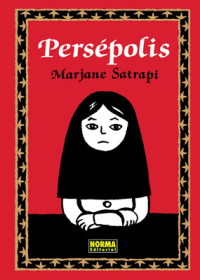Persepolis
by Marjane Satrapi
This entry was created for the Fall 2014 semester by Nancy Salto.

Author Bio
Marjane Satrapi was born in Rasht, Iran in 1969, but grew up in Tehran. Her parents were secular Marxists and raised Marjane to oppose injustice. When Iran’s Islamic Revolution began, her parents expressed opposition to the shah and participated in protests, even bringing Satrapi along. The family stopped attending protests, however, when they turned violent, and soon thereafter, they came to the conclusion that the revolution would be worse than the regime they’d overthrown. A favored uncle of Satrapi was even imprisoned by the shah’s regime, but later executed by the rebels. After the danger grew to be too much, Satrapi’s parents decided to send her to study in Austria. After a brief rebellious stint and a period of homelessness, Satrapi returned to Iran to attend college. Satrapi graduated from L’Ecole de Beaux-Arts in Tehran and later returned to France, to study at Arts Deco in Strasbourg. During her studies, Satrapi found influence in Art Spiegelman and was inspired by his book Maus to create the critically praised Persepolis: The Story of A Childhood. Since then, Persepolis has become an animated film and gained a sequel. Satrapi has also maintained her political activism, speaking out against discrimination in French politics, as it is now where she resides. Though Satrapi has spoken out against political injustices in Iran, she has not returned to the country for fear of her personal safety. Satrapi’s stories have since expanded to include Embroideries, Chicken with Plums, some children’s books, and much more. Critically hailed by leading feminists and scholars alike, Satrapi has made a mark on the scene with combined artistic ability and literary talent.
Discussion Questions
-How has the American media created our perception of Iran/Iranian people and how does the author challenge these preconceptions? What political statements does the author make in this regard, if any?
-How does the oppressiveness of the regime present itself in figures of authority in Marji's life? How does it present itself in the community?
-Would you consider the graphic content in the novel gratuitous? Does the violence detract from the novel?
-How does the novel utilize light/absence thereof in the novel's art to create mood and tone? Is it an effective artistic strategy for linking the literature and art?
-What literary and artistic tactics does the author combine to encourage the reader identifying with the main character?

